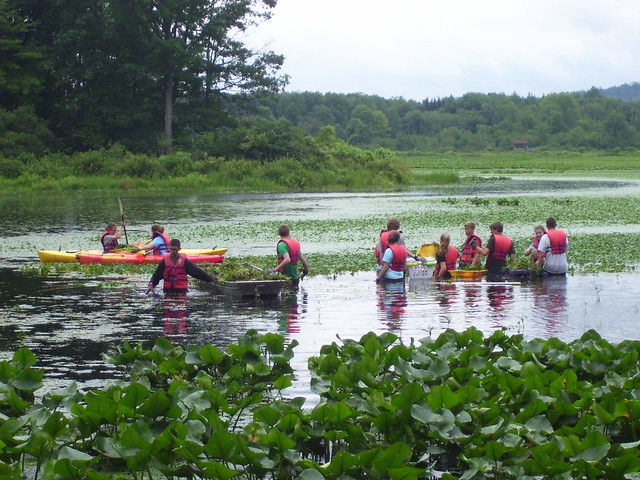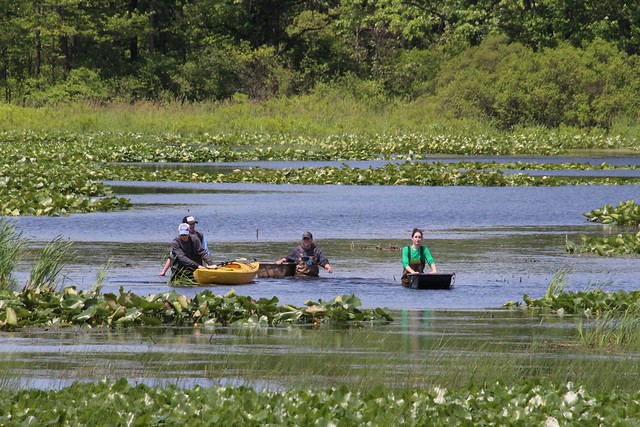It was peaceful out in the middle of the pond. The wind rustled the cattails, creating a rippling rush of sound that whooshed in from the distance and faded off behind me. The occasional loud monkey-like call of a nesting Common Gallinule echoed out of the deep grass. Geese honked in the distance and the far off sounds of kids’ joyful screeching rode the wind.
I was standing up to my waist in mud and water in the center of Big Pond at the Audubon Community Nature Center. It may be the most peaceful part of the property. The pond is about forty acres in size and the center of the pond feels like a world unto itself. Everything else recedes into the distance until the only thing that matters is this point in this pond at this moment. It is delightfully focusing.
Focus is important, because I am part of the effort to eradicate Water Chestnut from Audubon’s ponds. Water Chestnut floats on the surface of the pond in small circles of Christmas-tree-shaped leaves. These leaves are a slightly lighter shade of green than other leaves in the pond.
Pulling Water Chestnut is easy, but each circle of leaves requires a delicate touch. Reach down and gently grab the stem that stretches to the muck at the bottom of the pond. Gently tug on it to pull up a black, spiky seed with the stem to get to the root of the problem. Repeat. Repeat again. Repeat again and again and again until the plant is gone.

Audubon has been working to remove Water Chestnut from the pond for several years. When the problem was first addressed, staff and volunteers would pull canoe-loads of Water Chestnut from the pond. The Water Chestnut was so thick and covered so much of the pond that birds were often seen walking across the top of the water on the floating leaves. In short, the problem seemed hopeless.
That hopeless feeling is part of what makes Water Chestnut, an alien invasive plant from Europe and Asia, so bad. If left unchecked, it covers the surface of a pond from one side to the other with a thick layer of floating leaves that shade out the other plants in the water, creating a dark, watery biological desert below.
At Audubon, years of pulling Water Chestnut has made a huge difference. The effort has happened on many fronts. There have been many, many volunteer Water Chestnut pulls, along with paid staff that have pulled it out and staff from the Western New York Partnership for Regional Invasive Species Management (WNY PRISM) based in Buffalo.

They say that many hands make light work, but there was a lot of heavy lifting from a lot of people to get the Water Chestnut problem to the point it was as I stood in the water, hunting for bright green, newly sprouted plants and not finding many.
Audubon’s Invasive Species crew has cleared the pond of Water Chestnut more than once this year, but the amount of the plant they are finding is small compared to years past. Water Chestnut seeds can remain viable in the muck for a decade or more, so the pulling needs to continue until every viable seed has sprouted and the pond is clear. That day may never come, but I dream of a day when a few dedicated volunteers can sweep through the pond several times a year and clear the problem.
Volunteers are always welcome to help pull the Water Chestnut. The ACNC Water Chestnut crew goes out every Monday, Wednesday and Friday morning to pull. Contact Jeff Tome at (716) 569-2345 to schedule a time to go help control the Water Chestnut this summer. It truly is a beautiful place to work.
Audubon Community Nature Center builds and nurtures connections between people and nature. ACNC is located just east of Route 62 between Warren and Jamestown. The trails are open from dawn to dusk as is Liberty, the Bald Eagle. The Nature Center is open from 10 a.m. until 4:30 p.m. daily except Sunday when it opens at 1 p.m. More information can be found online at auduboncnc.org or by calling (716) 569-2345.


Recent Comments